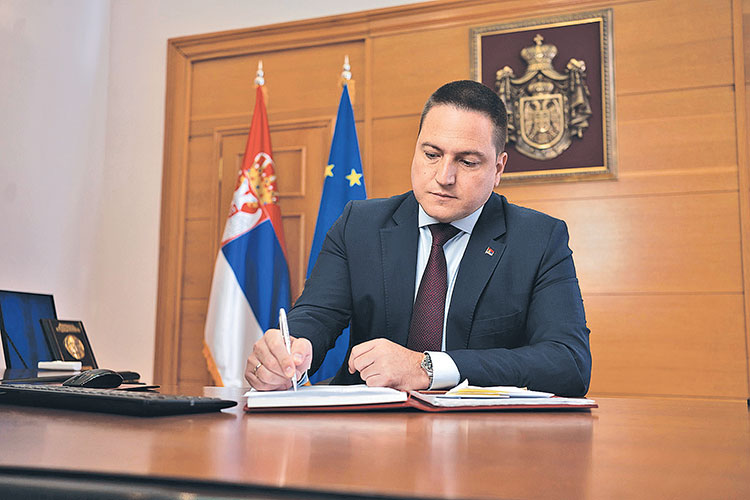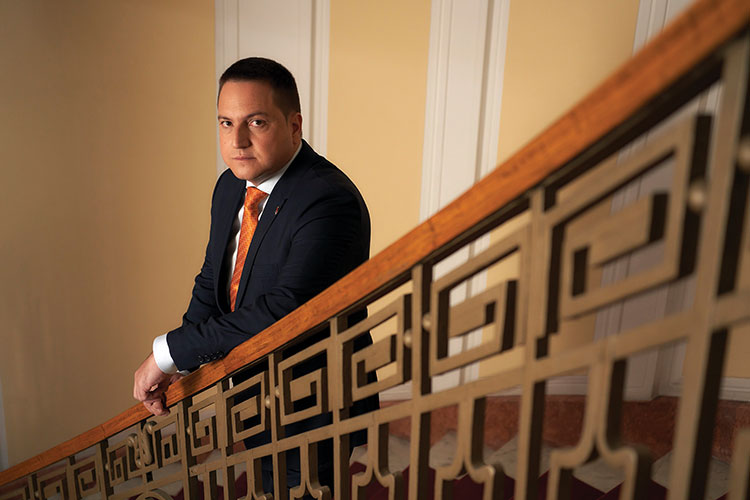By adhering to the framework established under the Education Strategy 2030, the Ministry is working – in cooperation with numerous partners – to create conditions to ensure the greater inclusion of children in preschool institutions, the development of dual education in secondary schools and higher education, and teacher training that forms the basis of every successful education system
The Strategy for the Development of Education and Upbringing until 2030, which the Government of Serbia adopted in June 2021, represents the foundation for the systemic improvement of education and upbringing. This strategic document keeps pace with the continuity of the reform process conducted at all levels of education over recent years. According Serbia’s First Deputy Prime Minister and Minister of Education, Science and Technological Development, Branko Ružić, the new strategy will “enable the inclusion of even more children in education, the monitoring of the demands and needs of the labour market and, in accordance with that, the development of the knowledge, skills and competencies of pupils/students”.
Considering the importance of developing competencies among both pupils and teachers, the Strategy has envisaged their improvement and the modernisation of teaching and learning processes, as well as the conditions under which teaching is conducted.
When it comes to the inclusivity of education, we can see that the new strategy places great emphasis on increasing the inclusion of children in preschool education and introducing compulsory secondary edu cation. What are the necessary prerequisites for these two goals to be met?
The Ministry, in cooperation with numerous partners, is working to create conditions for the greater inclusion of children in preschool institutions. The total percentage of the inclusion of preschool-age children is experiencing a growth tendency, alongside the traditionally high inclusion of children in the years prior to starting school.
Our goal is to secure good, modern conditions for children and the work of educators in nursery schools, to impact on reducing waiting lists to enrol in preschool institutions, but also to provide parents with support.
One of the activities that should enable the capacities of nurseries to increase is the Inclusive Preschool Education Project, which we have been implementing on the basis of a World Bank loan since 2018. Upon realisation, this project will secure 11,000 new places in nurseries across Serbia. Likewise, in cooperation with the Novak Đoković Foundation, we are working to adapt and convert the existing spaces of nursery schools in multiple cities.

Apart from this, the new Basic programme of preschool education has been applied successively in preschool institutions since 1st September 2019. The experiences of institutions implementing the Godine uzleta [Years of Rising] programme are positive, and changes are evident in the spaces where children learn, in the ways their learning is supported and in their participation among the community of their peers.
When it comes to the introduction of compulsory secondary education, which is also envisaged in the Strategy for the Development of Education and Upbringing until 2030, an important prerequisite is the amending of legal regulations and the Constitution.
One of the changes that’s prompted the most comments in the past is certainly the introduction of dual education. Where is its place in this strategy and how much will the schools that provide this type of education be represented now that secondary school education is becoming compulsory?
Dual education occupies an important place in the Strategy for the Development of Education and Upbringing. The strategy envisages a system for monitoring and evaluating the National Model of Dual Education, in order to be able to reach a conclusion on the sustainability of dual education, the extent to which employability increases for students and what the positive effects are in terms of increasing the competitiveness of the economy. The number of companies interested in cooperating with schools is growing every year, while the number of schools involved in the dual education system is also growing continuously. Approximately 150 secondary vocational schools are currently included in this system, implementing 54 dual educational profiles. The economy has expressed its need for specific profiles of personnel, which led to an initiative to develop 14 new dual educational profiles, including for example tourist technician, industrial robotics technician, railway safety technician, haberdasher etc.
Interest is simultaneously focused on the introduction of dual education to tertiary education. What will this fundamentally change compared to the approach of existing programmes for educating personnel in this way?
The dual model of studies in higher education represents a form of cooperation between employers and higher education institutions, which – given employers’ active participation in both creating and implementing study programmes – should contribute to improving the relevance of higher education from the aspect of labour market needs. The dual model, in contrast to the standard one, is unable to be implemented without the inclusion of employers, with whom work-based learning would be implemented. The creation of dual study programmes should be based on the objective needs of employers for qualified staff with specific developed competencies. The ratio in the number of hours of active teaching that should be conducted at the higher education institution and work-based learning with the employer is determined by the study programme, with active teaching – encompassing lectures, exercises and other forms of active teaching – must be represented by an average of at least 450 hours of the entire study programme per year, while work-based learning should also encompass an average of at least 450 hours per year at the level of the entire study programme.
Since the start of the 2021/2022 academic year, dual study programmes are being implemented at higher education institutions in Serbia for the first time. There are currently 32 study programmes accredited under the dual model of study, at nine higher education institutions
Due to the relevant practical experience gained, students who complete their studies under the dual model have significantly increased labour market competitiveness and will have better chances of gaining employment with the employers with whom they carried out their work-based learning, but also with other employers engaged in the same field.
The Strategy’s priorities include the development of competencies and human resources, and the modernisation of teaching and learning processes, including the conditions under which they take place. This requires the significant modernisation of education staff. How much resources – both material and human – are realistically needed to implement this?
We are working continuously, through various projects and in cooperation with partners, to digitalise and improve the system to the greatest possible extent, but also to improve processes and conditions for learning in our schools. That’s why the plan includes the equipping of another 21,500 digital classrooms. Likewise, at the end of last year, with the aim of improving teaching practises, the Ministry allocated 7,000 computers and 480 printers to primary and secondary schools throughout Serbia. We are also continuing with these activities this year, and the plan is to allocate almost 20,000 computers for IT cabinets. About 18,500 computers are also planned to be allocated to teachers. This will certainly help with the further specialisation of teachers, while providing support to students and encouraging the digitalisation of teaching processes.
The strategic goals also include increasing the achievements of pupils in final exams and reducing the number of those who drop out of school. According to some information, 25 per cent of pupils who complete primary school today don’t enrol in secondary school. How can this be fixed?
Data show that around 99% of eighth grade pupils take the final exam. With the aim of improving the achievements of pupils and ensuring greater fairness in the education system, the Ministry is taking steps to improve conditions for working and learning. Pupils and teachers are this year preparing for the final exam at the end of primary education that is harmonised with the new primary school teaching and learning programmes. Accordingly, schools have also already started organising preparations for sitting the final exam, as well as additional teaching.

Interestingly, of the total number of pupils who complete primary school, 97% enrol in secondary school. When it comes to the remaining three per cent of pupils, they certainly include children who won’t continue with secondary education, but it should be considered that this number also includes pupils who are enrolled in private, international schools, the military academy and religious schools, as well as students who will leave to study abroad.
The draft of the education strategy until 2030 foresees the establishing of online state online primary and secondary schools. Will this be a complementary modality for situations like pandemics or a comprehensive transition to hybrid education?
It certainly isn’t about a comprehensive transition to online education, but rather about different instruments for the support of teaching and learning. For example, this model can be used to support education in rural areas, education for children with disabilities, for athletes, as well as for pupils that are resident abroad. The goal is for the education system to have digital materials ready and active learning activities designed, which will be easily distributed to all schools in the system and ensure an appropriate level of quality for remote education if it is needed in the future, but also under regular circumstances as a form of support to other schools in the transition to hybrid teaching, which is encompassed by the development plans of practically all schools.
The establishing of online state primary and secondary schools can be used to support education in rural areas, in education for children with disabilities, for athletes, as well as for pupils that are resident abroad
Last, but certainly not least, we’ve been reading for years about the introduction of the ‘State Matura’ exam, but it seems that this government’s term will expire without it having been introduced. Will the next government be able to follow in your footsteps and finally introduce it?
The State Matura [school-leavers’ matriculation exam] will be introduced for three-year secondary schools in the 2022/2023 academic year, and for general, art and vocational school graduation in the 2023/2024 academic year. The decision was taken to shift the date of introducing the State Matura because it is a project that requires comprehensive preparations for each segment of the process. We’ve also adopted amendments to the Law on the Fundamentals of the Education System, in order to create conditions in a timely manner for efficiently and professionally preparing for the implementation of the State Matura.
In order for us to once again verify the quality of tasks and procedures at the level of the system, we will organise a second state matriculation pilot exam from 4th to 8th April 2022. This second pilot should be conducted in 519 public schools and all private schools that have applied for inclusion in the pilot project.
All teachers will thereby receive an opportunity to see what the state matriculation exam will look like. I must remind your readers that our intention is for the State Matura, in the final epilogue, to have a certification character, i.e., for it to confirm the level of knowledge acquired by pupils in secondary vocational schools, art schools and high schools, but also for it to have a qualification character, in terms of passing and enrolling in certain higher education institutions.
| SUPPORT Our goal is to secure good conditions for children and the work of educators in nursery schools, to impact on reducing waiting lists to enrol in preschool institutions, but also to provide parents with support | IMPROVEMENT We plan to allocate around 18,500 computers to teachers. This will certainly help teachers to further advance, provide pupils with support and encourage the digitalisation of teaching processes | MATRICULATION The State Matura exam will be introduced for three-year secondary schools in the 2022/2023 academic year, and for general, art and vocational school graduation in the 2023/2024 academic year |
|---|